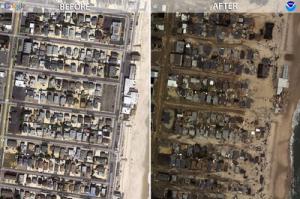Disaster recoveryFEMA funding for post-Sandy recovery in New Jersey exceeds $6.8 billion
In the three years since Hurricane Sandy scored a direct hit on New Jersey, FEMA has provided $6.8 billion to date to help the state recover and rebuild. FEMA Public Assistance, which provides funds for repair and rebuilding of infrastructure and public facilities as well as necessary work such as debris removal and emergency response, has obligated $1.809 billion in Public Assistance funds towards repair and rebuilding projects in New Jersey.

Before and after images of some of Sandy's damage // Source: noaa.gov
FEMA says that in the three years since Hurricane Sandy scored a direct hit on New Jersey, the agency has provided $6.8 billion to date to help the state recover and rebuild.
This money has helped to restore critical facilities, clear debris, replace boardwalks along the Jersey Shore, rebuild public infrastructure, and reimburse municipalities throughout the state for the enormous costs of clearing debris and restoring public safety in the immediate aftermath of the storm.
FEMA notes that the agency’s National flood Insurance program has paid out more than $3.5 billion in claims to flood insurance policyholders whose homes were damaged or destroyed by the storm. Through FEMA’s Individuals and Households Program (IHP), the agency approved $422.9 million in payments to Sandy survivors.
FEMA Public Assistance, which provides funds for repair and rebuilding of infrastructure and public facilities as well as necessary work such as debris removal and emergency response, has obligated $1.809 billion in Public Assistance funds towards repair and rebuilding projects in New Jersey.
As the work of rebuilding continues, FEMA is helping to strengthen the state’s capacity to withstand a future disaster. Thirty-nine percent of all Public Assistance (PA) projects have accompanying mitigation projects. FEMA is funding projects that protect vulnerable facilities from inundation by storm waters, raise homes above the flood plain and convert neighborhoods that have experienced repeated and devastating flooding to public, open space. Eighty-six percent of all New Jersey PA projects over a half-million dollars have a mitigation component.
To date, the FEMA’s Hazard Mitigation Grant Program has obligated $258,456,164 million for a series of mitigation measures that includes voluntary property acquisitions in communities subject to repetitive flooding, energy allocation, retail fuel, infrastructure, home elevations and planning projects, including $30.9 million for home elevations in flood-prone areas and $9.7 million for the Retail Fuel Station Program. The RFS is a voluntary grant program designed to enhance the operational resiliency of retail fuel stations statewide by funding the installation of back-up generators capable of operating fuel pumps when power outages occur.
